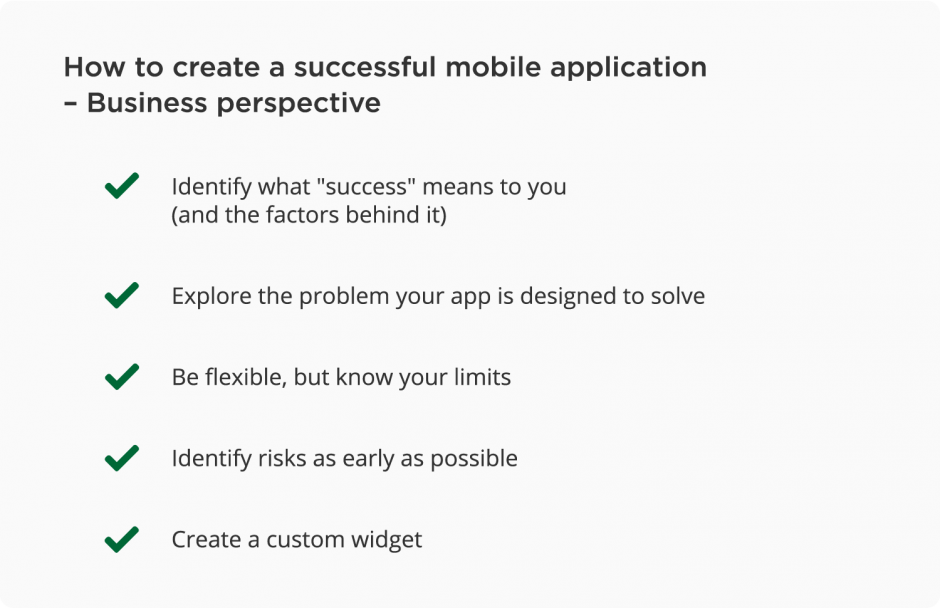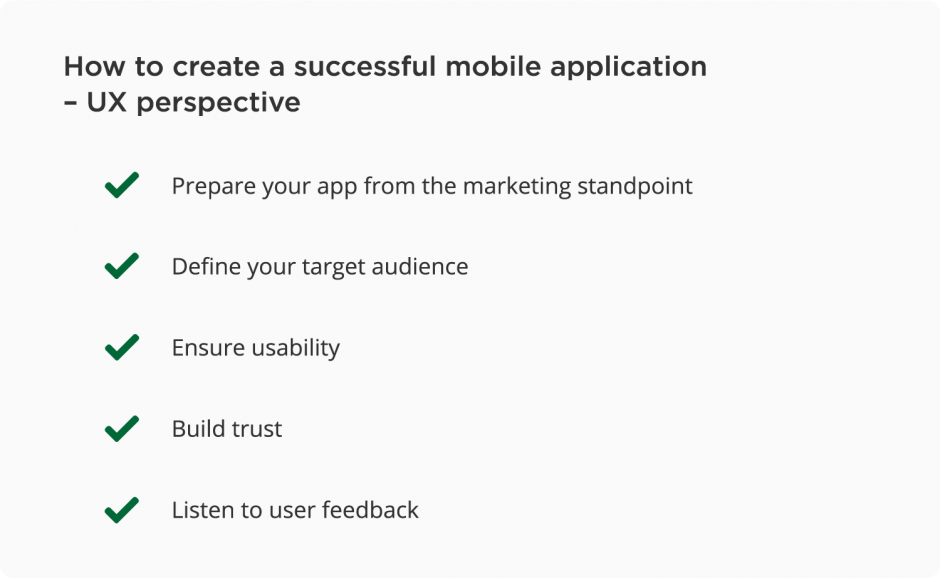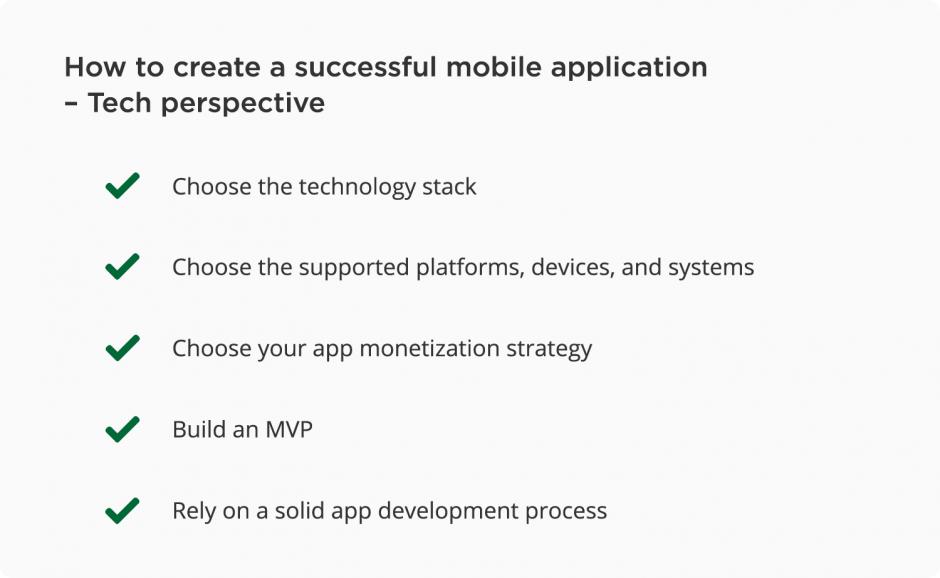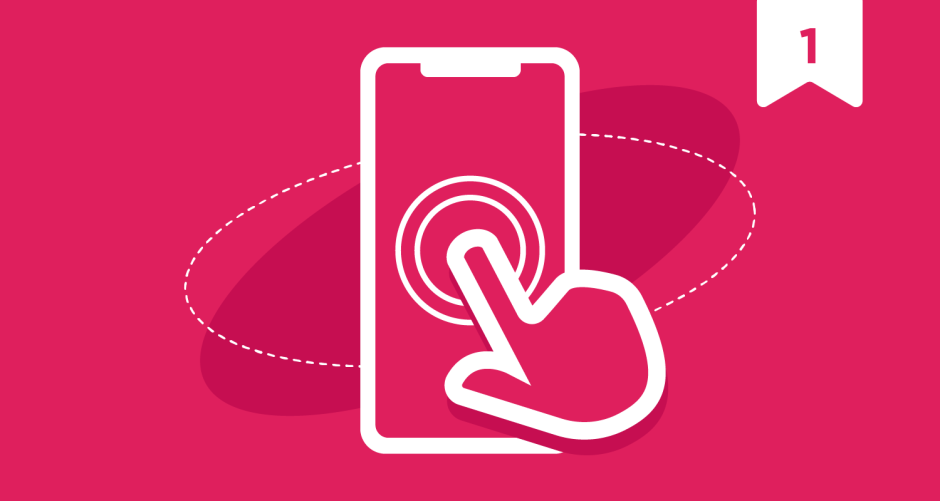Table of contents
Creating a successful mobile application is not a piece of cake. So far, we’ve looked at many different aspects of building a mobile application on our blog. We explained what a mobile app is, how the app development process looks like, and how much mobile app development costs in 2021.
But what does it take to create a mobile app that achieves success? To tackle this topic, we decided to ask three experts from areas such as UX/UI design of a mobile app, business development, and technology to share some tips.
Read on to find out how to approach building a mobile app to ensure that it achieves your business goals (and brings you glory and fame, of course).
Skip to a section:
1. A business perspective on creating a successful mobile app
Here are a few tips from our Business Analyst, Ireneusz:
Identify what “success” means to you (and the factors behind it)
To tell whether your application is successful or not, you need to first define what success means to you. It’s all about the metrics or events in the lifecycle of the application that you define as your objectives.
How else will you be able to talk about success? By definition, a successful mobile application is one that attracts many users and notes a lot of traffic inside the application. But you can add other parameters that are relevant to your business, such as quality or financial ones.
- Daily and monthly active users
- Daily sessions per daily active users
- Retention rate
- Churn rate
- Cost per acquisition (CPA)
- User lifetime value (LTV)
Explore the problem your app is designed to solve
Don’t forget that a mobile application is only a tool. The ultimate success of your product will depend on whether it helps users to solve a problem successfully. Many business owners find the basic task of identifying the problem challenging.
Remember that even the most attractive application based on innovative technologies and free of bugs won’t guarantee success if it doesn’t perform its basic role: solving a business problem.
How to explore the problem your app solves?
- Start by identifying your target audience and learning more about it – not only the demographic data, but also their preferences and habits regarding digital products.
- Use Product Canvas to bring all of your marketing materials to a single place and validate your solutions. Product Canvas combines user stories with personas, storyboards, design sketches, scenarios, and other UX artifacts.
Prepare your app from the marketing standpoint
To succeed, you need to build an image for your application that clearly communicates what the app is about to your target audience. Show which consumer needs your app fulfills or how it solves problems. Make sure that your application is easy to find in the crowd of other mobile products.
Be flexible, but know your limits
If you read any guide to software development, you’re bound to hear about how we all need to become agile and quickly react to the changing needs of our target customers. Most of the time, this approach leads to success. However, don’t forget that pivoting comes with its consequences.
If you design an application to solve a particular problem, it’s very unlikely that the problem will change this often. So, be flexible – but only within the boundaries of your problem. Avoid redefining the problem over and over again. Otherwise, you risk wasting your time and money.
Identify risks as early as possible
One of the most common problems among business owners (and especially startup founders!) is being too optimistic about the product. Sure, it’s good to be enthusiastic about your vision. But in business, being realistic about the risks and problems is a far safer direction.
Stakeholders who are part of building the product vision might hide or diminish risks that might become critical during later stages in the development or lifecycle of the application. The sooner you know the risks, the better. That way, you get a chance to document and analyze them. Once a risk becomes a reality, you’ll be able to react faster and more accurately.
Before we go further, let’s sum up the business tips on how to create a successful mobile app:
2. UX design
Here are a few tips from our UX/UI Designer, Jakub:
Define your target audience
Achieving success without this step is impossible. Before you set out to build your product, you need to know who is going to use your application – and for what. The business section of this article covers the basics of this step. But in the context of UX, defining the problem is more related to identifying how every element of your app creates a streamlined user flow directing users to their goal.
Define the problem your application solves. And then translate it into the design of your app, where every single element and interaction should shape the way to solving this problem as smoothly as possible. Be clear about the value proposition of your app before moving to the development phase. Not clarifying this at the outset will cost you a lot later on in fixes and pivots.
Ensure usability
When designing your solution, make sure that it’s clear and usable – i.e., it provides an environment for users to perform the tasks efficiently while enjoying the experience. Don’t reinvent the wheel. Use common themes, transitions, icons, and navigation features. You’ll find them in UI toolkits or starter kits. That’s how you make sure that your app is easy to use by people who have experience in using mobile apps.
If you’re building an m-commerce app, you can find a list of such elements here: Top 24 E-Commerce Mobile App Features
Build trust
To achieve success, your application should make users feel unique and appreciated. Transparency and trust are key goals that should form the foundation for the interactions between the application and its users.
How to build trust with your app? For example, you can create a user-friendly and functional customer service system. You can also build a transparent and trustworthy rating or review system. These are just examples of the many ways you can build trust among your app users with design to increase their engagement and loyalty.
Listen to user feedback
Don’t forget that the application you’re building isn’t intended for you, but your target audience. That’s why you need to keep a close eye on how your users are responding to it. Ask users to review your app, use in-app net promoter score (NPS) surveys, and leverage beta testing.
Listen to user feedback and transform it into new features or improvements. Always grow your application in line with the suggestions made by your user base. This is a sure-fire path to success.
Before we go to the next part, let’s sum up the UI tips on how to create a successful mobile app:

3. UI design
Grab the attention of consumers
When releasing a mobile application, prepare to face a lot of competition. Make sure that your app attracts the attention of users. You can do that by investing in a custom design, animation, illustrations, or even 3D images.
Make the interface usable
When designing the user interface of your app, aim for usability, simplicity, and clarity. Focus on the main features of the application to avoid distracting users from the elements that build the user flow. Maintain the right balance or hierarchy between different visual elements (visual hierarchy). Essentially, the most important components of your app need to be more visible than other, less important ones. Check this article to read more about mobile app design trends.
Don’t forget about accessibility
Make sure that your application is accessible. Remember to address the needs of people with disabilities. When designing your user interfaces, remember to choose the right contrast.
Before we go further, let’s sum up the UI tips on how to create a successful mobile application:

4. Technology
Here are a few tips from our iOS & Flutter Developer, Damian:
Choose the technology stack
The technologies you pick for building your digital product are a critical factor in shaping its success. Depending on the timeframe, budget, and your app’s level of complexity, you can choose from different options.
When building a mobile app development, you can choose from three approaches that will determine your technology stack: native, cross-platform, and hybrid.
a. Native mobile development
This means that you will be building your solution individually for each operating system. Such an approach requires teams to follow platform-specific guidelines carefully and use different software development kits, environments, and interface elements provided by Android and iOS. It’s easy to integrate native solutions with the mobile ecosystem and provide users with exceptional stability, speed, and security. That’s why so many businesses choose native solutions over a hybrid or cross-platform app development.
However, this approach requires significant investment because you’ll need two teams to complete an application project for you because each is limited to one specific platform.
b. Cross-platform mobile development
Such apps can work on multiple OS – all it takes is writing a single code base that can be later used for different operating systems simultaneously.
Many business owners choose to build cross-platform solutions because, with this approach, they can get their app out faster to the market and accomplish that with a smaller budget. On top of that, a cross-platform solution will reach a wider audience.
However, depending on the technology you choose, a cross-platform solution might not deliver the performance or user experience comparable to native ones. Some of the most popular cross-platform technologies used today are React Native and Flutter.
If you’d like to learn more, check out this article: Flutter vs. React Native – What to Choose in 2021?
c. Hybrid mobile development
Hybrid applications are basically websites packed up in native containers. That’s how they can access specific platforms or device features. They are built with standard web tools and technologies such as HTML 5, CSS, and JavaScript. Hybrid apps look native and can be distributed through app stores.
The undeniable advantage of building a hybrid solution is that you get one solution that works for multiple platforms. Generally, hybrid solutions also come with the benefit of quicker launch and lower development costs.
But they also cause issues such as slower performance, higher risk of code vulnerabilities, lack of scalability, and potentially costly post-release maintenance.
Choose the supported platforms, devices, and systems
Before launching the development phase, you need to decide which technologies, devices, and operating system versions your app is going to support. To do that, pay attention to the market share of each technology, especially when making a decision about the operating system versions.
The more systems you decide to support, the more development work your application will require. This decision is also closely related to your budget. So, take a closer look at the market to understand which system versions your app should support to balance the costs and accessibility.
Choose your app monetization strategy
Ultimately, to be successful, your application needs to generate revenue. That’s why you should look into your monetization options already at the planning stage. For example, you can:
- Offer your app at a charge in the app store – in this variant, you’ll be asking users to pay a amount before downloading the app on their devices.
- Rely on in-app ads and purchases – this strategy is based on providing app users with extra features or helpful elements at a price.
- Launch subscription programs – subscriptions are a sub-type of in-app purchases. Here’s how they work: once a user downloads an app, they often start a free trial to experience all of the app features. When the trial period is over, they need to pay a weekly/monthly/yearly fee to maintain access to these features.
All of these strategies have their pros and cons, so do your homework before settling on one.
Build an MVP
Your first step should be building a Minimum Viable Product (check out what is MVP). By delivering a product equipped with basic functionalities to your target audience, you can analyze their reactions, gather feedback, and introduce the required changes or improvements based on their suggestions. This will get you a few steps closer to success, which is building a digital product your target audience wants to use.
Learn more: How to Build a Minimum Viable Product – MVP Guide for App Owners
Rely on a solid app development process
Before starting to work on the application, plan how you’re going to build it. This is the moment when your development team chooses the tools, external libraries, and software architecture. These decisions are usually made as soon as the app requirements are defined. Get our Free Guide for Product Owners: Drive your Product to Success.
Make sure that your app is tested as new functionalities are implemented. Make sure to cover all the scenarios tracing how the app is going to be used by end-users. Don’t forget about edge cases. Take advantage of tools that support the development process. For example, Continuous Deployment (an approach in which teams develop software in short cycles) can help you reduce the time needed to build and deliver an application version for testing – and positively impact the overall cost of building your application.
Let’s sum up the technology tips on how to create a successful mobile app:

How to create a successful mobile app – summary
We hope that our expert tips and best practices help you in building a successful mobile application. Success on the mobile market is based on many different factors: the usability of your app, its capability to solve problems successfully, and how it addresses the key needs of your end-users. But you can position your app for success right from the start by implementing these tips.
Why outsource app development to Droids On Roids?
At Droids On Roids, we have been delivering iOS app development services and Android app development services for more than nine years, helping companies all over the world, including countries such as the USA, UK, Norway, Switzerland, and Australia. We developed more than 130 mobile and web applications for clients operating across many different sectors.
Our teams follow a six-step Quality Assurance process to provide our clients with the best quality of development services. We also follow the Scrum framework and other industry standards to deliver the highest business value.
If you’re looking for an experienced mobile development team, get in touch with us. We have the talent and expertise you need to make your app a success.







